Guidelines for Effective Design and Application of Cast Iron Materials
The Art and Science of Cast Iron Design
Cast iron, a material that has been utilized for centuries, stands as a testament to both craftsmanship and engineering innovation. Renowned for its durability, excellent casting properties, and versatility, cast iron has become a favored choice in various industries, from construction and manufacturing to culinary arts. Understanding the principles behind cast iron design not only enhances its aesthetic appeal but also maximizes its functionality.
Historical Background
Cast iron was first used in ancient China around the 5th century BC, subsequently evolving through various cultures and applications. Its widespread use in Europe began during the Industrial Revolution when the demand for strong, malleable materials surged. Today, cast iron is celebrated not only for its practical applications but also for its rich historical significance and aesthetic qualities.
Properties of Cast Iron
The unique properties of cast iron are attributable to its high carbon content, typically ranging between 2% to 4%. This composition provides a combination of strength and brittleness, making it ideal for a variety of structural applications. Additionally, cast iron's excellent fluidity allows for intricate designs and fine details, making it suitable for artistic endeavors.
One of the remarkable traits of cast iron is its ability to withstand high temperatures, making it a popular choice for cookware and engines. Moreover, cast iron has exceptional wear and corrosion resistance, particularly when treated with protective coatings, further establishing its longevity in demanding environments.
Design Considerations
When embarking on a cast iron design project, several critical factors must be considered to ensure both aesthetics and functionality.
cast iron design

1. Type of Cast Iron Understanding the different types of cast iron—such as gray, ductile, and white cast iron—is fundamental. Each type has distinct properties that influence its design possibilities. For instance, ductile cast iron offers enhanced tensile strength, while gray cast iron is preferred for intricate patterns due to its ease of machining.
2. Weight Distribution In architectural applications, weight distribution plays a crucial role in stability and support. Designers must analyze load-bearing capacities and ensure that the cast iron elements can withstand the forces they will encounter throughout their lifespan.
3. Surface Texture The surface finish of cast iron not only affects its appearance but also its performance. Textured surfaces can enhance grip in cookware, while smooth finishes may be preferable for decorative elements. Additionally, the choice of surface treatment can prevent corrosion, adding to the material’s durability.
4. Thermal Conductivity Cast iron has excellent thermal retention and distribution properties, which is particularly advantageous in cookware design. When designing cookware, the thickness and shape of the cast iron can significantly influence how heat is absorbed and distributed, affecting the cooking process.
5. Aesthetic Elements Cast iron can be molded into intricate designs and patterns, making it ideal for decorative applications such as gates, railings, and furniture. Designers often draw inspiration from historical motifs, ensuring that contemporary designs pay homage to the rich traditions of ironwork. The incorporation of color through enameling or other finishing techniques can also enhance aesthetics.
Sustainability and Innovation
As the world increasingly shifts toward sustainable practices, the cast iron industry is also evolving. Innovations in recycling processes allow for repurposing old cast iron components, thereby reducing waste and conserving resources. Additionally, advancements in manufacturing techniques, such as 3D printing of molds, promise to revolutionize the production of cast iron components, offering new design opportunities while minimizing material usage.
Conclusion
The design of cast iron components is a harmonious blend of art and engineering. From understanding the myriad properties of cast iron to considering the intricacies of design and application, this material offers endless possibilities. Whether in the context of architectural elements, culinary tools, or artistic endeavors, cast iron continues to inspire and innovate, proving that timeless materials can adapt to modern needs while maintaining their historical significance. As we look to the future, the legacy of cast iron design will undoubtedly evolve, reflecting both our advancements and our appreciation for this remarkable material.
-
Wrought Iron Components: Timeless Elegance and Structural StrengthNewsJul.28,2025
-
Window Hardware Essentials: Rollers, Handles, and Locking SolutionsNewsJul.28,2025
-
Small Agricultural Processing Machines: Corn Threshers, Cassava Chippers, Grain Peelers & Chaff CuttersNewsJul.28,2025
-
Sliding Rollers: Smooth, Silent, and Built to LastNewsJul.28,2025
-
Cast Iron Stoves: Timeless Heating with Modern EfficiencyNewsJul.28,2025
-
Cast Iron Pipe and Fitting: Durable, Fire-Resistant Solutions for Plumbing and DrainageNewsJul.28,2025
-
 Wrought Iron Components: Timeless Elegance and Structural StrengthJul-28-2025Wrought Iron Components: Timeless Elegance and Structural Strength
Wrought Iron Components: Timeless Elegance and Structural StrengthJul-28-2025Wrought Iron Components: Timeless Elegance and Structural Strength -
 Window Hardware Essentials: Rollers, Handles, and Locking SolutionsJul-28-2025Window Hardware Essentials: Rollers, Handles, and Locking Solutions
Window Hardware Essentials: Rollers, Handles, and Locking SolutionsJul-28-2025Window Hardware Essentials: Rollers, Handles, and Locking Solutions -
 Small Agricultural Processing Machines: Corn Threshers, Cassava Chippers, Grain Peelers & Chaff CuttersJul-28-2025Small Agricultural Processing Machines: Corn Threshers, Cassava Chippers, Grain Peelers & Chaff Cutters
Small Agricultural Processing Machines: Corn Threshers, Cassava Chippers, Grain Peelers & Chaff CuttersJul-28-2025Small Agricultural Processing Machines: Corn Threshers, Cassava Chippers, Grain Peelers & Chaff Cutters












